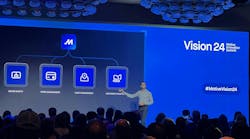A good trucker's atlas is about $100, needs no batteries or power, requires no user's manual or data entry, and can be tossed on the floor when you don't need it. So why are electronic navigation systems that are at least five times more expensive and increase the complexity factor by a far greater multiple beginning to find a ready market among commercial truck fleets?
The simple answer is that a navigation system can do something no paper-based map can — instantly calculate and adjust directions based on the truck's actual location and up-to-date information on all the restrictions, construction, closed roads, and even in some cases real-time traffic conditions that lay ahead. Drivers can quickly recalculate directions on the fly and compare shortest routes to fastest or toll-free alternatives, balancing cost, travel time and scheduling requirements. And all without one hand on the steering wheel and the other fumbling to unfold a map or page through an atlas. For more and more fleet operations, the potential improvements in productivity, safety and overall driver satisfaction are beginning to outweigh the initial costs or training of navigation systems.
With the consumer automotive market leading the way, nav systems “are showing massive year-over-year growth,” says Ed Siciliano, VP marketing and sales for ALK Technologies, the developer of PCMiler routing software as well as navigation software for both automotive and truck applications. “We believe that 2007 will be the year that navigation moves well beyond the early adopters and enters a traditional adoption curve.”
YEAR FOR TRUCKS
For truck fleets the tipping point is a rapidly expanding choice among systems that offer a variety of price-points and features. In 2007, commercial truck operators will be able to choose from integrated, standalone systems like those now found on high-end cars, add-ons that integrate with and draw on the electronic capabilities of wireless data systems, third-party applications for laptop and handheld computers, portable navigation devices, and even hosted systems for cell phones.
Depending on your particular operation, one of these systems probably offers just the right balance of cost and performance. Making the right choice, however, requires understanding how the systems differ once you get beyond the price tag.
First the basics. Like most asset tracking systems that provide real-time location for trucks and trailers, navigation systems rely on GPS (global positioning satellite) receivers to determine a vehicle's current position. That information is then interpreted by digital map databases that are far more detailed than the electronic maps used to display electronic breadcrumb trails for tracking systems. Using inputs for destination and route preferences, the system calculates a route and then begins directing the driver along that route. If the driver deviates from the plan, the system automatically recalculates and provides updated driving directions.
The main difference from the route optimization software used by many fleets for years is that navigation systems provide turn-by-turn directions in real-time. The better the accuracy and detail of the map database, the more reliable the directions. While accurate road databases are well established, the one obstacle for truck systems has been the lack of reliable truck-attribute data — legal or physical restrictions that prohibit trucks from passing over certain roads. Development of truck-attribute data is well underway (see sidebar), which is one important reason truck systems are expected to become more widely used in the next few years, but before deploying a system be sure you and your drivers understand the limitations of its database.
Now on to the pros and cons of the four main categories of navigation systems currently or soon to be available for commercial truck applications.
The most elegant approach to truck navigation integrates the map display into the dash and vocal directions into the truck's audio system.
Earlier this year Kenworth Truck Co. became the first heavy-duty manufacturer to offer such an integrated navigation system as standard equipment on three models ordered with a premium interior. With a touch-screen mounted in the right-hand dash panel for the map display, it delivers spoken turn-by-turn directions through the vehicle radio. It has 20 GB of onboard memory, half for storing map data for all of the U.S. and Canada, as well as locations for KW dealers and other points of interest. The other 10 GB are free for storing a driver's music files through the unit's built-in MP3 player.
Kenworth has been looking at various kinds of nav systems for four years, “but we've always focused on an integrated approach,” says John Duffy, manager for advanced technology. “The components are tested to truck standards for durability in that environment, and we think a dash mounted one might obscure the driver's view and a handheld unit distract them.”
This first commercial release is a standalone system that is not tied into vehicle speed sensors or other inputs that might allow it to back up GPS readings with dead reckoning calculations when the truck is in a tunnel or city street without access to the positioning satellites. It also uses a standard map data base, which means it does not have information on truck or height restrictions, instead relying on the driver to visually determine the suitability of a suggested street or route.
The next generation will be more highly integrated with the truck's other electronic systems, says Duffy, probably receiving and sending information to other sensors and systems over the J1939 data bus. Once truck-attribute map data becomes commercially available, it can also be downloaded to the current systems from any PC using a USB cable, he points out.
“The telematics industry is so fast-moving that our challenge is to take technology that's largely being driven by the consumer market and focus it on enhancing truck efficiency and asset management,” says Duffy. “So our initial system is aimed at reducing off-route miles.”
JUST FOR TRUCKS
The international automotive electronics manufacturer Siemens VDO has also developed an integrated navigation system specifically for heavy-truck applications. Designed for OEM installation, the new system is being introduced first in Europe in 2007 since that market already has truck-attribute map data available. North American availability will follow once databases here contain more verified truck information, according to Eric Kent, business development manager for Siemens VDO's commercial vehicle division.
Converting an automotive navigation system into a truck version takes more than simply adding height and weight restrictions, says Kent. “Even the routing algorithm has to be different,” he says. “The speed profile (for a tractor-trailer), for example, is quite different. Also fleets need to be able to set their own height, weight and other specifications because that impacts routing. With our system, you can change those attributes as a driver makes deliveries or pickups.”
The integrated approach offers some immediate benefits over an add-on system, according to Siemens officials. Even the first generation system will be connected to vehicle speed sensors and a gyroscope so it can use dead reckoning to determine location when the GPS receiver is unable to find a satellite signal. It can also draw data from an automated log to set routes that take into account available driving hours, choosing appropriate lay-over locations with available parking and other driver amenities.
Siemens believes that commercial operations with limited hours for drivers will also benefit from the navigation system's ability to receive real-time traffic reports over Europe's traffic-monitoring radio network. The system will reroute a driver around reported congestion automatically, but only if it determines there will be a significant time savings, according to Kent.
The next generation of the Siemens truck navigation system could deepen vehicle integration with an “e-horizon” feature already offered in European BMW cars. Drawing on terrain profile data and detailed information on road characteristics such as curve radii, it can anticipate road conditions much like a driver would, automatically adjusting engine output and gear selection through the truck's control data bus. The result would be measurably better fuel economy and improved safety on top of more efficient routing, says Kent.
While a dedicated navigation system integrated with the truck's dash display potentially offers the broadest array of features, it does add the cost of another electronics system to the price of the vehicle. Wireless data communications providers are developing another, less costly approach to navigation, offering it as an add-on for their next-generation onboard hardware. These systems already provide a driver display linked to a significant amount of computing power and data storage, as well as GPS tracking, which means they have all the elements required to run a dynamic navigation application.
LEVERAGING COMMUNICATIONS
Qualcomm's new OmniVision system, for example, will offer fleets an optional navigation application that will deliver spoken turn-by-turn directions. “The OmniVision hardware is already in the truck for productivity, so why not leverage that investment by adding a navigation application?” says Norm Ellis, vp and gm of transportation and logistics for Qualcomm Wireless Business Solutions.
Available early next year, the OmniVision navigation application will have truck-specific map data stored onboard with a 2GB SD memory card. “We've been building that database with our mapping partners by studying the 25,000 most frequently visited locations by our current customer base,” says Ellis. “Not only will our routing and rerouting be dynamic, but it will route the driver to the loading dock, not the front door of a facility. It becomes a quality-of-life feature for drivers, as well as allowing fleets to better predict arrival times and avoid service failures.”
Since wireless communications are already part of the package, Qualcomm is also working with its navigation partners to add real-time traffic and weather updates to the routing mix. “When we do that we want to be more predictive than reactive,” says Ellis. Telling a driver that they're stuck in traffic doesn't really help. Our approach will use traffic patterns and DOT road construction reports to help plan the route around anticipated problems.”
A new “smart” display unit from GeoLogic will offer similar navigation functions using an existing application from Maptuit. Both the hardware and navigation feature are expected to be available early next year.
ANY PLATFORM
While navigation is a natural add-on for a GPS-equipped wireless data system, many fleets operate without onboard communications systems. However most drivers do carry some type of smart device, whether it be a fully functional laptop, a handheld data device or even just a PDA or cell phone. A simple plug-in GPS receiver and a navigation application can turn also turn those devices into dynamic routing systems at relatively low cost. Better still, truck-specific map data is available for those smart device applications.
Under the CoPilot Truck brand name, “ALK makes navigation software that can run on just about any hardware platform,” says Ed Siciliano. “We can work with Windows CE, Symbian, Java, Linux platforms running on all sorts of devices.” It also offers a low-cost GPS receiver for devices that don't have them.
While two companies - Navteq and TeleAtlas — supply the digital map data for most navigation systems, ALK has actually developed its own for North American truck operations. “We use a variety of government sources (for the map data),” says Siciliano. “Then we collect GPS tracking data from our North American CoPilot users, which gives us an accurate picture of roads and their attributes. We overlay that data on electronic maps and make adjustments based on that information. We've gotten voluminous amounts of data on truck restrictions over time, so at this point any changes more fine-tuning than adding missing data.”
For laptops and other devices with the computing power to quickly calculate dynamic routes, ALK supplies its truck map database on a 1GB SD card. When a route is calculated, the CoPilot application shows the driver a map of the route along with an estimated time of arrival. Once the GPS receiver detects that the truck is moving, the system automatically removes the map and switches the view to large turn arrows and distance counters that can be quickly scanned by the driver.
Even drivers without portable computers or handheld data devices can now take advantage of navigation systems. Many cell phones used by field workers carry GPS receivers and are capable of running simple Java applications. For those phones, directions can be sent over the air from hosted applications, which can monitor the driver's progress using location information from the handset's GPS receiver and recalculate directions as necessary.
ALK currently has a partnership with Sprint to provide just such a hosted navigation system for its many Nextel service users. If a driver enters an address for a destination, the hosted application sends the handset turn-by-turn directions in near real-time. Alternately, a dispatcher can use ALK's website to enter the destination and the directions are automatically forwarded to the driver. All routes for the Sprint service are truck-specific.
LOW COST BUT SLOWER
This hosted approach has a number of advantages for fleets looking for no-frills navigation, including no upfront costs for the navigation application or map database, and no need to invest in expensive hardware.
The disadvantages are that there is a monthly service charge for each handset and communications charges each time directions are transmitted to the driver. Also since the map data isn't stored on the driver's device, if a driver misses a turn any route recalculation will not be in real time, but will have to wait for the host system to respond with new directions.
Paper maps, handwritten directions and even cellphone emergency requests for directions have served fleets well for quite awhile. However, technology now offers a better way for drivers to get where they need to go, a way that can improve a fleet's overall productivity by reducing out-of-route miles, make drivers' lives simpler by leading them right to their destinations, and improve safety by keeping trucks on the right roads and away from low-overpasses and weak bridges.
The crossover from consumer navigation systems to those specifically designed for trucks has taken awhile, but now you have a rapidly growing market that will let you choose a system that best suits your particular fleet operation and budget.
Understand the strengths and weaknesses of each, and you will be able to choose wisely.
Only as good as the data
Paper maps and routing software have provided truck attributes for years, offering fleets information on height and weight limits, hazardous materials restrictions, and even locations for truck services. But that information isn't good enough for new truck navigation systems that have to calculate turn-by-turn directions in real-time.
As one of only two global suppliers of digital map data, TeleAtlas “has provided the data for truck-route optimization systems for some time,” says Dana Fenner, fleet logistics market director. Now it faces the task of collecting and verifying all the additional data that's needed to power a dynamic real-time navigation system for trucks.
That's no small task since any such system has to take into account a wide variety of local truck restrictions as well as those on the national highway network. However both TeleAtlas and Navteq (the other supplier) are well along in efforts to create those databases for North American roads.
Both are using a “compilation model” to collect the truck attribute data. “We start by asking towns and cities to supply street and truck-restriction information,” says Fenner. “We're also getting aggregate truck-tracking information from Qualcomm and others, which shows us where large numbers of trucks travel. Then we can concentrate on those locations to verify the data.”
Mobile mapping vans fitted with sophisticated surveying technology physically travel some of the identified roads, and a field force is also deployed to check the supplied data.
Using those sources, TeleAtlas has collected truck-attribute data for 1,300 cities, as well as the national highway network — enough data for it to release its first truck-attribute database late last month. The navigation application for Qualcomm's OmniVision system will be among the first to use the new database.
Navteq is following a similar path, building the North American database for the Siemens VDO truck navigation system, among others.
A light-duty solution
Not every fleet needs to worry about truck height and weight restrictions. Although there are parkways and other types of roads that bar all commercial traffic, a light-duty fleet may find that a portable navigation device (PND) intended for private automobiles suits its needs quite well. Widely available from consumer electronics suppliers at competitive prices, such systems are designed to be easy to install and use, and tend to incorporate the most up-to-date navigation technology.
For example, entering the market next month, the Nav-U 712T from Sony combines a GPS receiver with real-time information on traffic from the RDS-TMC radio traffic network now operating in 49 U.S. cities. The combination allows it dynamically calculate routes that take traffic congestion into account, or to automatically reroute a driver around a bottleneck.
Other features of interest to fleet users include a database for all U.S. and Canadian roads stored on a 2GB resident flash memory, spoken directions through a built-in speaker tuned for voice, and an interface designed to minimize driver inputs. It also has a new suction cup mounting system that can be attached to irregular surfaces like a console as well as the windshield.
The suggested retail price for the Nav-U 71T is $499 including the map database and a 90-day trial subscription to the RDS-TMC traffic service.


